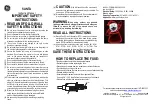
Data Files
©
2016-2017 SR Research Ltd.
85
parser is sufficient for most neuro-psychophysical research, including smooth
pursuit. Some cognitive research may ignore the saccadic data and only use the
fixation data produced by the EyeLink parser. The saccadic data produced for
saccades includes:
•
The time of the first and last sample in the saccade
•
The eye that generated the event
•
Start and end HREF or gaze position data
•
Peak eye-movement velocity
•
Start and end gaze-data angle
•
Gaze-data angular resolution
All of these data may appear in the ENDSACC event that terminates the
saccade. Only the starting data can appear in the STARTSACC event that
initiates the saccade.
In a sorted EDF file or a text ASC file (produced by EDF2ASC) that contains
both samples and events, the STARTSACC event will precede the first sample in
the file that is part of the saccade, and the ENDSACC event will follow the last
sample in the saccade. This allows the sample data in the files to be processed
as saccade or fixation in a single pass. The data contained in STARTSACC and
ENDSACC events may be configured by modifying the DATA.INI file for the
EyeLink tracker. Saccadic events may be eliminated entirely, if only fixation
data is required. By default, STARTSACC events are configured to contain only
the start time of the saccade.
The peak and average velocity data for saccades is especially valuable for neuro-
psychophysical work. These are the absolute velocities measured as the
Euclidean sum of x and y components. The EyeLink parser computes velocity
by use of a multiple-sample moving filter adjusted for different sampling rates.
This is optimal for detection of small saccades, minimizes the extension of
saccade durations, and preserves saccadic peak velocities.
Other data in the ENDSACC event may be useful for some types of analysis.
The start and end position, and start and end resolution, may be used to
compute saccadic amplitude. This is more easily done by multiplying average
velocity by the saccadic duration:
dist = 1000.0 * (end_time - star 1.0) * avg_velocity;
In general, the saccadic amplitude will be slightly less than the distance
between average position of the preceding and following fixations, as saccades
do not include sub-threshold velocity parts of the eye movement that precede
and follow the rapid phase.
4.5.3.5 Blinks
The STARTBLINK and ENDBLINK events bracket parts of the eye-position data
where the pupil size is very small, or the pupil in the camera image is missing
















































